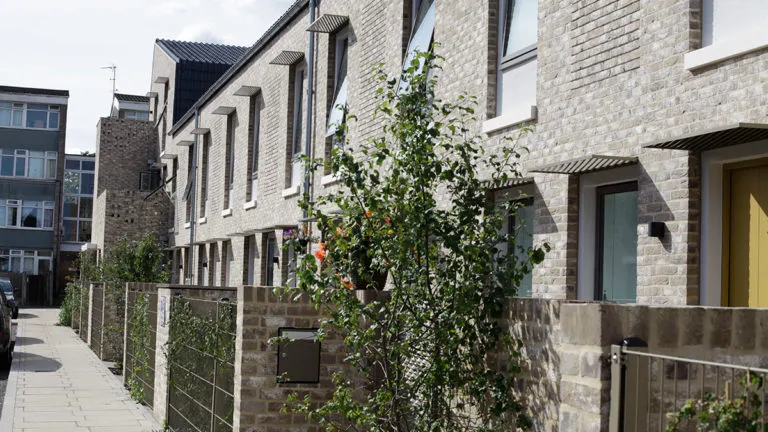Goldsmith Street winning the Stirling Prize shows that councils can lead the way in building more social housing
Published: by Alastair Ball

Last night a significant moment in the history of social housing occurred. Goldsmith Street in Norwich became the first social housing project to win the RIBA’s Stirling Prize, the country’s most prestigious architecture award. The judges described Goldsmith Street as ‘a modest masterpiece’, while Guardian architecture and design critic Oliver Wainwright said: ‘This year’s choice sends a clear message that, despite government cuts, it is eminently possible for brave councils to take the initiative and build proper social housing.’
Goldsmith Street is a remarkable housing development – a beautiful, modern estate of 105 social homes inspired by the Victorian terraced houses in the nearby Golden Triangle area of Norwich. Designed by London-based architects Mikhail Riches and Cathy Hawley for Norwich City Council, it’s owned by the council and is 100% social rent housing with secure, permanent tenancies.
Built in accordance with the strict requirements of the German Passivhaus standard, Goldsmith Street includes some of the most energy efficient homes in the UK. As a result, it should save tenants a massive 70% on their fuel bills. As this is social housing aimed at people on lower incomes, it means that it should only cost tenants £150 a year to heat their homes – an amazing achievement that will go a long way to ensure residents can afford to heat their homes.
Goldsmith Street’s design has also considered the need for the estate to foster a sense of community, something often easier in social housing than private rented housing because secure tenancies mean people know they will be able to stay long-term. Each home also has its own outside living area and there are shared communal alleys between houses with benches and tables, together creating space for children to play and for tenants to socialise with each other. These shared spaces encourage interaction between tenants, supporting the development of strong communities.
Above all, Goldsmith Street challenges the perceptions some still hold about social housing and demonstrates that it can provide among the very best new homes in the country.
Investing in social housing
A major programme of social housing is clearly needed in England. It’s the only tenure that will help the more than one million people on waiting lists and the hundreds of thousands of households already experiencing homelessness.
In addition, like Goldsmith Street, social housing developments must be seen as an investment. Unlike normal housing developments, which are a model built on delivering short-term returns on investment, social housing offers local authorities, housing associations, or central government a long-term return through rental payments. On top of this, there are savings to be made through a reduction in the housing benefit bill and through less need to house families in expensive temporary accommodation.
In fact, work done as part of Shelter’s independent commission on social housing showed our proposals for three million new social homes to end the housing emergency could pay for itself after 40 years.
So, the economic case for social housing is simply inarguable. And Goldsmith Street does not just show us an economic argument, but also one based on delivering the very best homes and delivering them for local communities. These are homes that local people can be proud to live in and that the local council can be proud to have delivered.
More like this
We know that councils up and down the country want to be building more homes, and Goldsmith Street demonstrates that councils can be leaders in this new generation of social house building. However, we shouldn’t pretend that it will be easy.
Access to both land and finance remain significant barriers to overcome in delivering new social homes, let alone new social homes of the quality that Norwich has achieved. This is why Shelter continues to campaign nationally on issues like reforming our broken land market and increasing the amount of funding available for delivering new social homes.
On top of these issues that need national action, there is also a need for local areas to do everything they can they can to effect change.
In Norwich, the presence of a Cabinet Member for Social Housing specifically was likely a part of enabling this to happen. A committed individual or team with the responsibility to drive forward projects like Goldsmith Street is always going to be needed to overcome the barriers we know exist. Creating a Cabinet Member for Social Housing might not be the whole answer to getting Goldsmith Street recreated in other areas, but it is surely not a bad idea for more local councils to take the idea up.
Last night’s victory for Goldsmith Street is a significant moment in the history of social housing in England. A moment when 100 years after the Addison Act, local authorities began to demonstrate once again that they have the skills, the vision, and the desire to build the homes their community needs.
At Shelter, we want the government to make it far easier for more social housing like Goldsmith Street to be built. However, we need your help to put pressure on politicians to act. Join our campaign for more social housing.